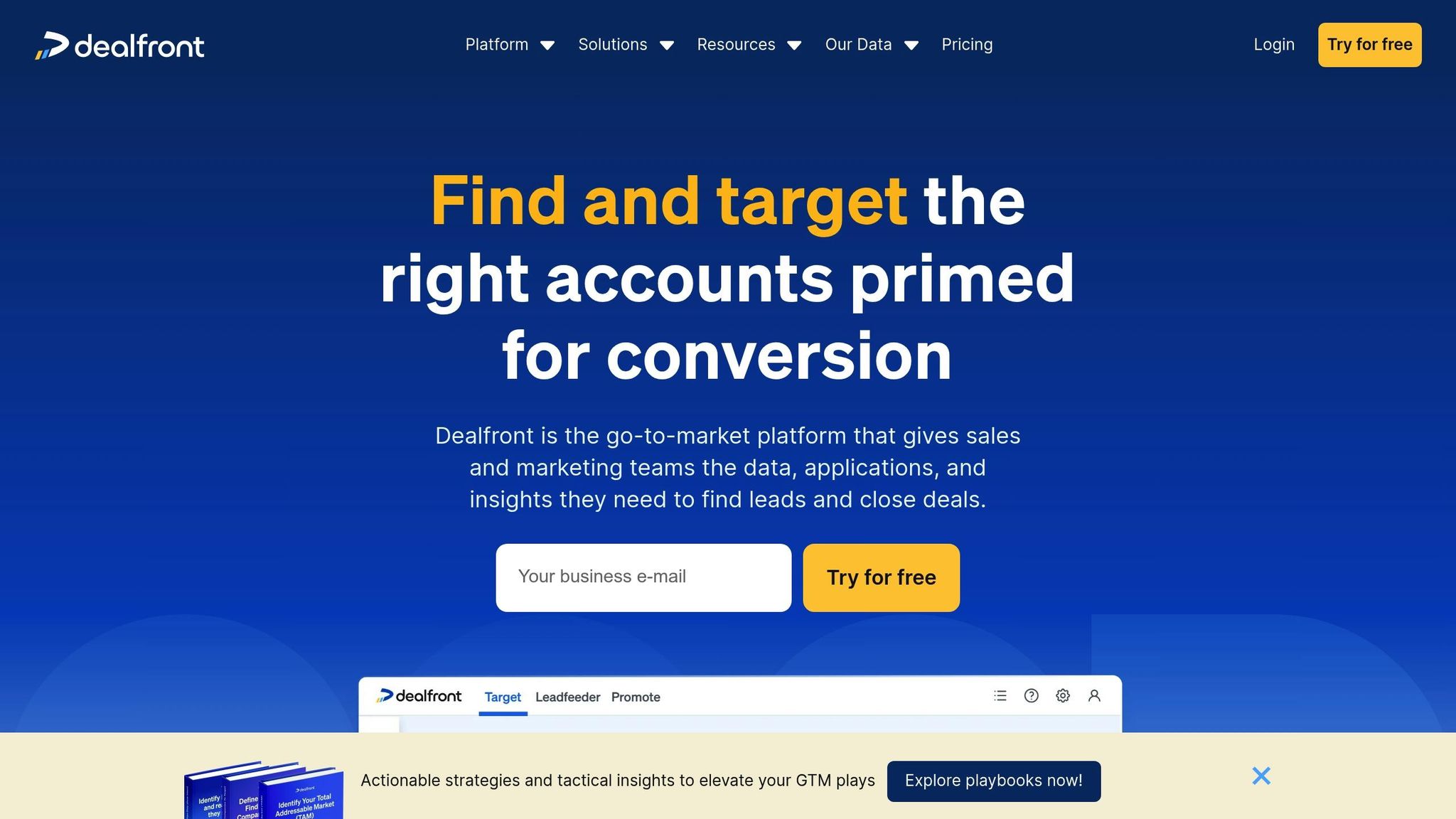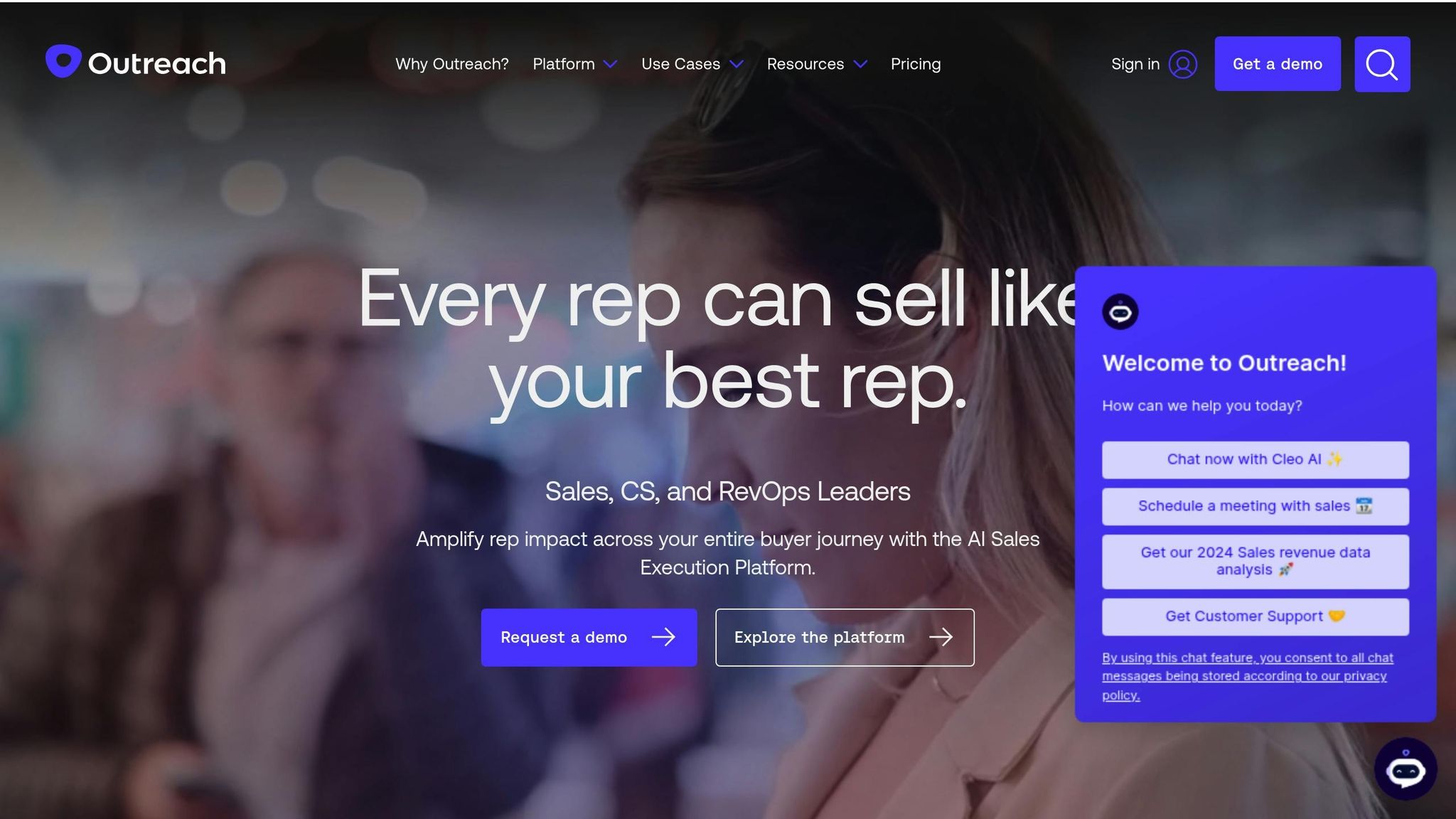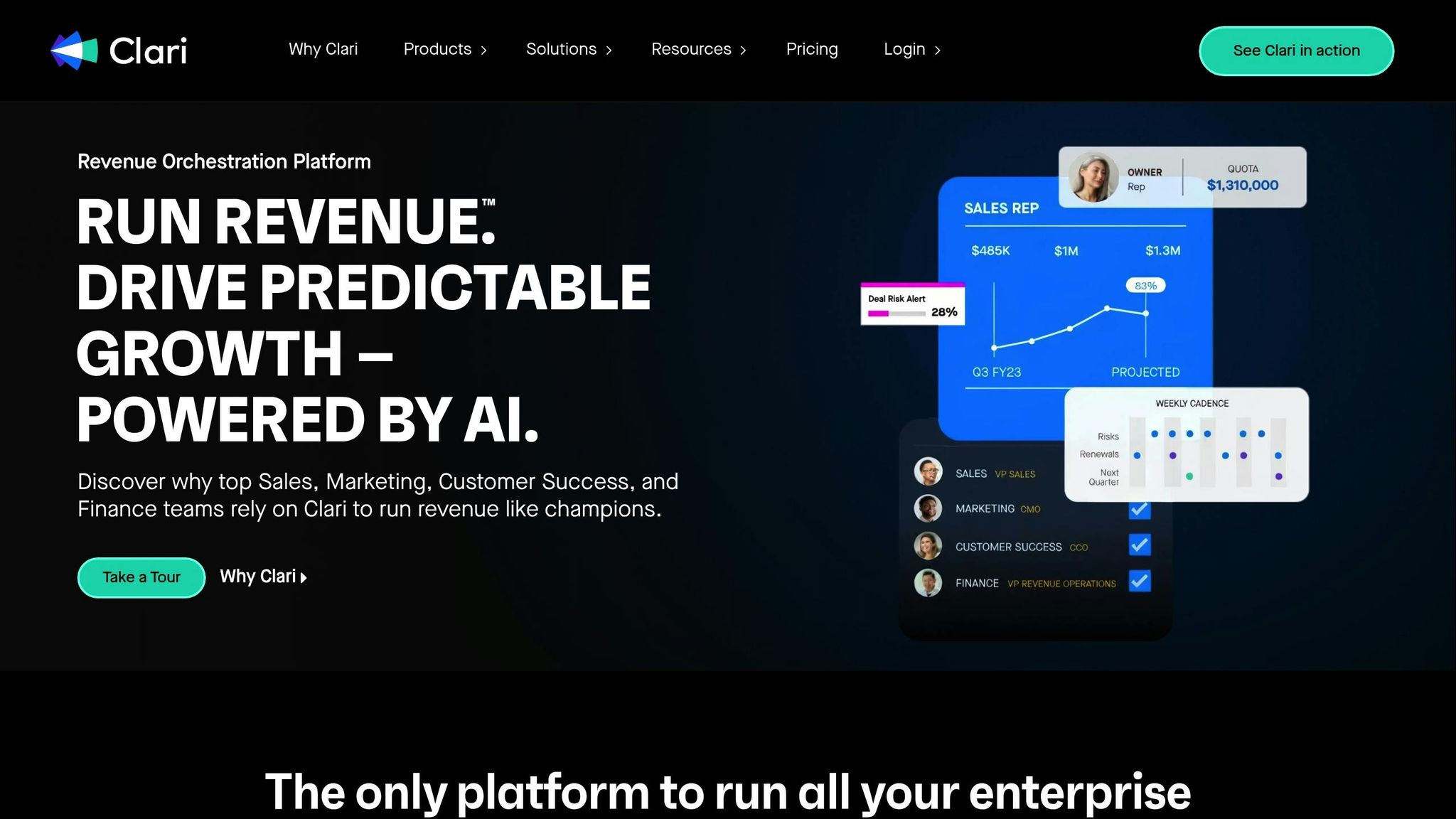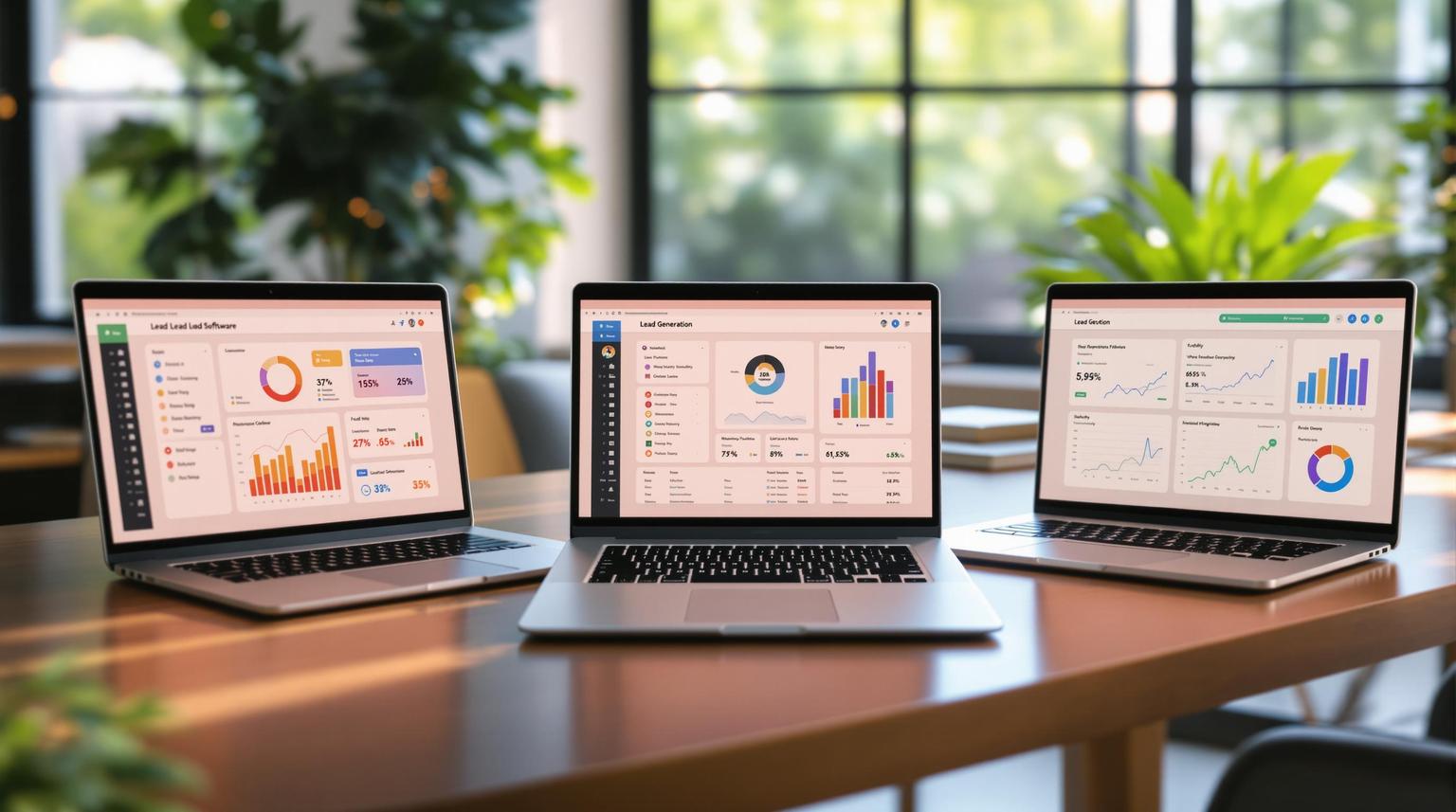B2B sales automation is no longer optional in 2025 - it’s essential for saving time, increasing revenue, and staying competitive. Companies using AI-powered tools report up to 30% revenue growth, 20-30% cost reductions, and faster sales cycles. Here's what you need to know:
- Key Features: AI-driven CRM systems, lead scoring tools, and sales forecasting platforms streamline workflows and improve decision-making.
- Top Platforms: Tools like Dealfront (lead generation), Outreach.io (multi-channel engagement), and Clari (pipeline management) deliver measurable results.
- Trends: AI sales assistants and privacy-first automation are shaping the future, with tools like Salesforce Einstein and IBM Watson leading the way.
- Action Plan: Evaluate your needs, integrate automation with your current systems, and train your team to maximize ROI.
Quick Comparison of Top Platforms:
| Feature | Dealfront | Outreach.io | Clari |
|---|---|---|---|
| Best For | Lead Generation | Multi-Channel Engagement | Pipeline Management |
| Key Strength | Intent Analysis | Conversation Coaching | Forecasting |
| Performance Impact | 30% more leads | 25% higher conversions | 10% improved win rates |
Takeaway: AI-powered automation tools help businesses save time, improve lead quality, and close deals faster. Start by identifying your needs, choosing the right platform, and aligning teams for success.
Introduction to B2B Rocket.ai: AI-powered B2B Sales Generation & Automation Software
Key Features of B2B Sales Automation Tools
Modern B2B sales automation tools leverage AI to streamline sales processes, focusing on three main capabilities. These features cater to the growing need for personalization and data-driven decisions, which are crucial for staying competitive in today's market.
AI-Powered CRM Systems
AI-enhanced CRM platforms now do much more than just manage contacts. Using Natural Language Processing, they can extract and update customer details from emails, calls, and meetings automatically[8]. They also use predictive analytics to assess past data, helping sales teams forecast customer behavior and tailor their strategies[9].
Some standout features include:
- Prioritizing tasks based on urgency or value, ensuring sales reps focus on what matters most[9].
- Delivering real-time insights to aid decision-making[10].
- Two-way platform synchronization, offering efficiency improvements similar to those seen in early adopters[7].
Lead Scoring Systems
While CRMs manage data, lead scoring systems analyze it using AI. These tools evaluate various data points to rank leads effectively:
| Data Type | Focus Area |
|---|---|
| Behavioral | Tracks website visits, email opens, content downloads |
| Communication | Examines email content, chat logs, and call transcripts |
| Firmographic | Considers company size, industry, and tech stack |
| Historical | Reviews past purchases and interaction history |
Companies using AI-driven lead scoring report a 30% boost in close rates and a 20% revenue increase[12]. These systems continuously refine their models to improve accuracy based on real-world outcomes[11].
Sales Forecasting with AI
AI-powered forecasting tools provide valuable insights for revenue planning. By combining predictive models with live data, these tools offer highly accurate projections[13] and can identify unusual patterns that signal risks or opportunities[4].
Key capabilities include:
- Simulating various market scenarios to predict outcomes.
- Automatically updating forecasts with live data streams[13].
- Translating complex data into easy-to-understand insights.
Leading Sales Automation Platforms in 2025
These platforms showcase how AI tools can deliver measurable results in sales:
Dealfront: Data-Driven Lead Generation

Dealfront is known for its precise intent detection and extensive contact database. Users have reported 30% more qualified leads and 25% faster sales cycles[2]. The platform's intent analysis aligns directly with the lead scoring methods discussed earlier.
Key highlights of Dealfront:
- Real-time company insights that guide personalized outreach
- Cross-channel activity tracking for better engagement
Outreach.io: Multi-Channel Sales Tools

Outreach.io centralizes sales activities, improving productivity by 40% and increasing conversions by 25%[10]. Its features include:
- AI-driven email assistance
- Real-time call coaching through voice intelligence
- Seamless integration with LinkedIn Sales Navigator and over 100 other tools[2]
Clari: Sales Pipeline Tools

Clari enhances win rates by 10% and improves forecasting accuracy by 20%[3][10]. It brings AI forecasting models to life with:
- Real-time pipeline updates for better visibility
- AI-enhanced forecasts
- Cross-channel activity tracking to monitor deals effectively
Comparing Key Features
Here's a quick comparison of what each platform brings to the table:
| Feature | Dealfront | Outreach.io | Clari |
|---|---|---|---|
| Best For | SMBs | Mid-size companies | Mid-market organizations |
| Key Strength | Lead Generation | Multi-channel Engagement | Pipeline Management |
| AI Capabilities | Intent Analysis, Lead Scoring | Conversation Coaching, Content Generation | Deal Risk Assessment, Forecasting |
| Performance Impact | 30% more qualified leads | 25% higher conversion rates | 10% increased win rates |
"The integration of AI-guided selling solutions has become crucial for B2B sales organizations, with 75% expected to augment their traditional playbooks by 2026"[3].
Each platform caters to different needs. Dealfront is ideal for lead generation, Clari thrives in managing complex sales pipelines, and Outreach.io stands out for its multi-channel tools and extensive integrations[10].
How to Set Up Sales Automation
A well-thought-out plan is what separates successful sales automation from those that fall short. Companies with detailed rollout strategies see results that are 2.3 times better than those without [9]. By combining automation with AI-powered tools like CRM and forecasting systems, businesses can achieve real operational improvements.
Evaluating Your Company's Needs
Before diving into automation, take a close look at your current sales processes. According to a 2024 McKinsey report, businesses targeting repetitive, high-volume tasks managed to cut manual work by 40% and boost sales productivity by 25% [6].
| Assessment Area | What to Evaluate |
|---|---|
| Process Mapping | Identify workflows, bottlenecks, and tasks handled manually |
| Data Quality | Check for accuracy, completeness, and consistency |
| Tech Stack | Review current tools and their ability to integrate |
| Team Skills | Assess technical know-how and training requirements |
| Budget | Balance implementation costs against expected returns |
Integrating with Existing Systems
Successful integration hinges on careful planning. When done right, it can increase tool adoption by 35% [10].
Here’s how to ensure smooth integration:
- Audit your systems: Confirm API compatibility and identify gaps.
- Standardize your data: Use consistent formats across all platforms.
- Run tests: Conduct pilot tests before rolling out fully.
Training Your Team on AI Tools
Even the best tools, like Outreach.io's real-time coaching features, need proper onboarding to deliver results. A 2024 LinkedIn Learning report found that teams using interactive training retained 60% more of the skills they learned [15].
"Projects with excellent change management were six times more likely to meet or exceed project objectives", according to a 2024 Prosci study [5].
Effective training should include:
- A step-by-step approach, starting with basic features and advancing over time
- Hands-on exercises using actual sales data
- Ongoing support through mentors, checklists, and performance metrics
These steps work whether you're using a lead generation tool like Dealfront or a pipeline manager like Clari. By focusing on preparation, integration, and training, your sales automation efforts are more likely to succeed.
sbb-itb-9cd970b
2025 Sales Automation Trends
As we move into 2025, sales automation continues to evolve, with AI and data privacy taking center stage. Here are the key developments shaping the landscape:
AI Sales Assistants
AI sales assistants are becoming indispensable in sales processes, going beyond simple tasks to manage complex negotiations through conversational AI. For instance, Salesforce's Einstein now handles 85% of routine inquiries, streamlining workflows and saving time [9]. These tools are delivering real results:
- 20% shorter sales cycles thanks to automated follow-ups.
- 15% higher win rates driven by voice analytics.
A standout example is Chorus.ai's real-time coaching feature. By analyzing sales calls as they happen and offering immediate feedback, it has boosted conversion rates by 20% [16].
Data Privacy in Sales
Data privacy is no longer optional - it's a core requirement in B2B sales automation. Platforms like IBM's Watson AI have stepped up, reducing identifiable data by 60% while maintaining effective personalization through advanced anonymization techniques. Similarly, Microsoft's Azure Purview ensures 95% compliance with data protection regulations by automating policy enforcement.
Some notable privacy-focused innovations include:
- Google's differential privacy, which reduces re-identification risks by 90%.
- IBM's encrypted data analysis, enhancing security without sacrificing functionality.
- Drift's low-data personalization, which has led to a 35% boost in engagement.
HubSpot's "Privacy-First" initiative is a great example of how transparent data practices can drive results. By prioritizing user trust, they’ve achieved a 25% increase in opt-in rates for personalized communications.
These advancements address the challenges faced by tools like Dealfront and Outreach.io, showcasing a shift toward balancing cutting-edge technology with ethical data handling and regulatory compliance. This trend is especially important for platforms managing European accounts, where data protection laws are particularly stringent.
Getting Results from Sales Automation
To make the most of 2025's AI sales assistant tools, businesses need to focus on how humans and AI can work together effectively.
Combining AI and Human Skills
Let AI handle data-heavy tasks, allowing sales teams to focus on building connections. This approach has helped companies cut sales costs by 15-20% [14].
Platforms like Outreach.io and Clari show how tasks can be divided efficiently:
| Task Type | AI Role | Human Role |
|---|---|---|
| Lead Qualification | Scoring and prioritizing leads | Planning strategies for key accounts |
| Customer Communication | Sending follow-ups and reminders | Managing critical negotiations |
| Data Analysis | Recognizing patterns, forecasting, tracking | Developing strategies and building relationships |
For instance, Dealfront users have significantly reduced lead response times by combining AI with human efforts [7].
Measuring and Improving Results
Focus on these metrics to gauge and refine your sales automation efforts:
- Conversion rate: Check how many leads turn into customers.
- Sales cycle length: Measure the time from initial contact to closing the deal.
- Customer Acquisition Cost (CAC): Assess how efficiently you're acquiring customers.
- Revenue per sales rep: Evaluate individual team member performance.
- Engagement rate: Monitor how actively prospects are interacting.
Companies that tracked these metrics saw a 35% boost in sales productivity [10]. It's also essential to keep your data clean and organized to ensure accuracy.
Aligning Teams for Better Results
Aligned teams perform better, achieving 38% higher customer retention and 36% faster sales cycles [1][16].
Here’s how to improve alignment:
- Provide shared CRM access for all teams.
- Set shared KPIs to encourage teamwork.
- Hold regular cross-functional meetings to review automation outcomes.
"Companies that successfully avoided common automation pitfalls achieved 45% higher ROI on their automation investments", according to the 2024 Forrester report.
When paired with platform integrations, these strategies can amplify results. Businesses that applied AI insights across departments improved their forecast accuracy by 25%.
Conclusion: Moving Forward with Sales Automation
Main Points Summary
B2B sales automation has become a major part of business success in 2025, with AI-powered tools reshaping how companies connect with prospects and streamline sales workflows. These tools focus on supporting human efforts rather than replacing them, as seen with AI sales assistants and privacy-focused platforms.
Some standout advantages include:
- 50% faster prospecting and meeting preparation [3]
- 90% of knowledge workers report job improvements [7]
- 15-20% higher ROI due to increased efficiency [7]
AI-driven CRM systems and forecasting tools have shown how blending technology with human expertise can create a powerful combination. AI takes care of data-heavy tasks, freeing up teams to focus on building relationships and closing deals.
Action Steps
-
Evaluate and Integrate Technology
Review current systems to identify integration opportunities [10]. -
Develop a Data Strategy
Ensure data practices comply with GDPR and other regulations [17]. -
Prepare Your Team
Equip teams with the skills needed to combine technical know-how with strategic thinking.
"While AI and automation offer significant benefits, it's crucial to maintain a balance between technology and human touch in sales processes", says the 2025 Sales Automation Report [8].
FAQs
Which tool is best for lead generation?
The best tool depends on your business size, goals, and specific needs. Some of the top tools for 2025 include:
- Dealfront for visitor tracking
- Outreach.io for multi-channel outreach
- ZoomInfo for intent data
- HubSpot (rated 4.4/5 on G2) and Salesforce for full-stack solutions
HubSpot is ideal if you're looking for a platform with integrated CRM and marketing features. On the other hand, Salesforce stands out for enterprise-level scalability and advanced features like Einstein AI.
When choosing a tool, focus on factors like:
- How well it scales with your business growth
- Whether it aligns with your ROI goals
- Access to AI-driven lead scoring
- Industry-specific functionalities
For tools with built-in AI scoring, check the ones highlighted in our Key Features section. Make sure the tool you select integrates smoothly with your existing systems and supports your team's training needs.



